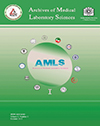Demodicosis: A Neglected Cutaneous Parasitic Disease in Face Lesions Examination
Archives of Medical Laboratory Sciences,
Vol. 1 No. 2 (2015),
12 Mehr 2015
https://doi.org/10.22037/amls.v1i2.10298
Abstract
Background: Demodicosis in humans was caused by two species of Demodex called folliculorum and brevis. The disease is seen in male and female. Although, there is no clinical symptoms in individuals with normal immunity system, but in many cases, dermatitis, rough, dry and scaly skin rosacea, particularly asymmetrical papulopustular or granulomatous variants and in some cases, perioral dermatitis, blepharitis [inflammation of the eyelid margins] are observed. In this report 16 cases of demodicosis diagnosed in recent years are presented.
Cases: Suspected patients with dermatophytosis who referred to the laboratory were examined in this study. In sampling, slide preparation and microscopic evaluation Demodex species was observed. In two cases, co- infection of dermatophytosis and demodicosis were demonstrated. Seven [43.75%] out of 16 patients were male and nine [56.25%] were female. In this study, 16 persons [4- 52 years old] were considered. None of the patients had any information about their disease and the cause .The patients were referred to the laboratory for fungi examination.
Conclusion: Demodicosis is a cutaneous parasitic disease and it is necessary that the parasitologists and mycologists consider the demodicosis during the sampling, preparation of slide and microscopic examination of cutaneous lesions.
- Type Demodex folliculorum
- Demodex brevis
- demodicosis
How to Cite
References
Del Rosso JQ. Update on rosacea pathogenesis and correlation with medical therapeutic agents. Cutis.2006;78[2]:97-100.
Goldsmith Lowell A. Fitzpatrick's Dermatology in General Medicine. McGraw-Hill Professional; 2012. ISBN 71669051.
Woolley Tyler A. Acarology: mites and human welfare. John Wiley & Sons, Inc; 1988. ISBN 471041688.
Rufli T, Mumcuoglu Y. The hair follicle mites Demodex folliculorum and Demodex brevis: biology and medical importance. A review. Dermatologica. 1981;162[1]:1-11.
Pilehvar M, Zamanian A, Monsef AR, Mani-Kashani KH. Demodex folliculorum and rosacea. J Hamedan Univ Med Sci. 2001;22[4]:5-8.
Sibenge S, Gawkrodger DJ. Rosacea: a study of clinical patterns, blood flow, and the role of Demodex folliculorum.J Am Acad Dermatol. 1992;26[4]:590-3.
Pena GP, Andrade Filho JS. Is demodex really non-pathogenic? Rev Inst Med Trop Sao Paulo. 2000;42[3]:171-3.
Bonnar E, Eustace P, Powell FC. The Demodex mite population in rosacea. J Am Acad Dermatol. 1993;28[3]:443-8.
Crawford GH, Pelle MT, James WD. Rosacea: I. Etiology, pathogenesis, and subtype classification. J Am Acad Dermatol. 2004;51[3]:327-41. 10. Moravvej H, Dehghan- Mangabadi M, Abbasian MR, Meshkat- Razavi G. Association of rosacea with demodicosis.Arch Iran Med. 2007;10[2]:199-203.
Roihu Tia, Kariniemi Arja‐Leena. Demodex mites in acne rosacea. J Cutan Pathol. 2006;25[10]:550-2.
Junk AK, Lukacs A, Kampik A. [Topical administration of metronidazole gel as an effective therapy alternative in chronic Demodex blepharitis--a case report]. Klin Monbl Augenheilkd. 1998;213[1]:48-50.
Liu J, Sheha H, Tseng SC. Pathogenic role of Demodex mites in blepharitis. Curr Opin Allergy Clin Immunol.2010; 10 [5]: 505- 10.
Castanet J, Monpoux F, Mariani R, Ortonne JP, Lacour J Ph. Demodicidosis in an immunodeficient child. Pediatrics dermatology. 2008;14[3]:219-20.
Jansen T, Kastner U, Kreuter A, Altmeyer P. Rosacea-like demodicidosis associated with acquired immunodeficiency syndrome. Br J Dermatol. 2001;144[1]:139-42.
Monsef Alireza, Eghbalian Fatemeh. Histopathologic Study of Rosacea and the Role of Demodex Folliculorum. Iran J Pathol. 2006;[4]:169-72.
el-Shazly AM, Ghaneum BM, Morsy TA, Aaty HE. The pathogenesis of Demodex folliculorum [hair follicular mites] in females with and without rosacea. J Egypt Soc Parasitol. 2001;31[3]:867-75.
Maraghi S, Rafiei A, Kaydani GH. Human demodicosis: A report of 5 cases. Jundishapur J Microb. 2013;6[5]. DOI: 10.5812/jjm.7465.
- Abstract Viewed: 491 times
- PDF Downloaded: 639 times
